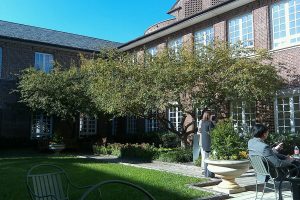This article is more than 5 years old.
In early November, I attended the Berlin 9 Open Access Conference in Washington, DC. Convened annually since the first Berlin conference in 2003 (in Berlin, Germany, hence the name, and where the Berlin Declaration was crafted), this was the first time the conference had been held in North America, and only the second time it had been held outside of Europe (it was in Beijing last year). In was an incredible experience, bringing together policy makers, administrators, researchers, librarians, funders, and publishers for two and a half days of presentations and discussions on the status of open access worldwide.
My conference started actually not with official B9 events, but rather a half-day tag-along meeting of the Coalition of Open Access Policy Institutions (COAPI). Founded in summer 2011, COAPI is a group of North American institutions that have faculty-adopted open access policies (institutional or departmental), or are actively working toward adoption. Thanks to the policy adopted by the ZSR Library Librarians’ Assembly, Wake Forest was one of the 22 founding member institutions, and I represented us at the COAPI’s first face-to-face meeting in DC at the National Academies of Science. Our conversation focused on three key topics: implementation; institutional repositories and open access policies; and, publisher responses to institutional policies. It was energizing having 30+ people in the room discussing strategy, logistics, challenges, opportunities, successes, and set-backs. I am eager to see how COAPI develops and look forward to our next group gathering, tentatively scheduled for March.
From my morning at the National Academies, I moved over to a building at Johns Hopkins University for two afternoon preconferences: the first on Open Access Publishing and the second on Open Access Policy Development. The most interesting facts I learned in the preconferences were from Peter Binfield, publisher of PLoS ONE and the Community journals:
- in 2011, PLoS will publish 17,000 (of 35,000 submitted), 14,500+ of those in PLoS ONE; this will account for approx. 1.6% of articles indexed in PubMed this year
- PLoS ONE is not only steadily gaining traction among authors, as evidenced by rising submission rates, but is also gaining stead competition from other publishers not wanting to be left behind: SAGE, BMJ, Nature, and others have launched “clones” in the past 18 months
The next day, the conference moved to the Howard Hughes Medical Institute campus in Bethesda, which is an absolutely breathtaking facility. I had expected a fairly sterile research facility composed of large, drag buildings, but was pleasantly surprised to find myself on a campus of deep red brick buildings with well-landscaped grounds and very comfortable furnishings (see below for a photo of the courtyard where I lunched the first day). Unlike the conferences I’m used to attending, there was only one session to attend at a time, so I never felt torn in deciding where to go. And since we were a smallish group (approx. 250 attendees) at a secure facility, we all felt comfortable staking our seats for the day and leaving our stuff behind while taking advantage of the ample conversation/networking time build-in between sessions.
The conference organizers did a great job of lining up panelists (each session was a panel, only 4 (long) sessions each day) that covered the broad spectrum of open access: from policy to business applications to humanities research opportunities to open education to research funders and the patients they serve. I am still, 6 weeks out, trying to process and synthesize everything, and think through how the work we are doing at Wake Forest can be expanded to better maximize the potential of open access. The biggest take away was the unofficial theme that emerged over the course of the two full days: the open access movement seems to be moving from content is king to context is key. This is a very important shift, as it indicates that our understanding and application of open access in publishing, archiving, and policy making is becoming more nuanced and unforeseen opportunities unfolding. A prime example that I learned of at B9 is that the World Bank is currently in the process of opening all of their data and publishing all reports openly, free for any and all to use, as they have come to understand that their mission is better accomplished by lifting artificial access barriers. Never thought I’d say this, but Go World Bank!
I am extremely grateful I had the opportunity to attend the Berlin 9 conference, not least because I returned to campus armed with great information to take before the Faculty Senate the following week, where I had been invited to speak regarding Wake Forest becoming an institutional signatory to the Berlin Declaration. As was reported at the most recent Librarian’s Assembly, the Faculty Senate was unanimously supportive of Mark Welker signing the Declaration on behalf of the University, and he did so in late November (although we’re still waiting to be officially listed). As amazing as this conference was, I’m keeping my fingers (and toes) crossed I get to go to Berlin 10 next year…in South Africa!!


4 Comments on ‘Berlin 9 Open Access Conference’
I know you had a great experience. And to continue my acronym education, is PLoS Public Library of Science?
Yes, PLoS is Public Library of Science! Sorry for the acronym oversight. 🙂
Sounds like a great experience. I have my fingers crossed for you:)
Molly thanks for this post and these stats! This post, your recent presentations to us and your talking points for liaisons are making me feel much more confident when talking about these issues with my faculty!